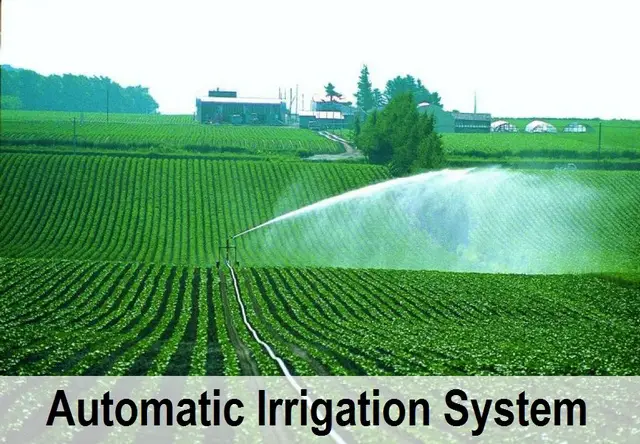This post may contain affiliate links which means I may receive a commission for purchases made through links. Learn more on my Private Policy page.
Hey there! Are you considering investing in an automated irrigation system for your garden or farm? In this article, we’ll explore the pros and cons of using automated irrigation systems. From increased efficiency and convenience to potential drawbacks like cost and maintenance, we’ll cover all the important factors to help you make an informed decision. Let’s dive in and see if an automated irrigation system is the right choice for you! Have you ever wondered about the benefits and drawbacks of using automated irrigation systems in your garden or farm? In this article, we will explore the pros and cons of these systems to help you make an informed decision on whether they are right for you.

Pros of Automated Irrigation Systems
Automated irrigation systems offer several advantages that can make gardening or farming more efficient and convenient for you. Let’s take a look at some of the key benefits of using these systems.
1. Conserves Water
One of the biggest advantages of automated irrigation systems is their ability to conserve water. These systems are designed to deliver the right amount of water directly to the plants’ roots, reducing water wastage compared to manual watering methods. By using sensors and timers, automated systems can adjust watering schedules based on weather conditions, soil moisture levels, and plant needs, ensuring optimal water usage.
2. Saves Time and Effort
Another benefit of automated irrigation systems is that they save you time and effort in watering your garden or farm. Once the system is set up and programmed, it will water your plants automatically, eliminating the need for you to manually water them every day. This can be especially useful for large gardens or farms where manual watering can be time-consuming and labor-intensive.
3. Promotes Plant Health
Automated irrigation systems help promote plant health by providing consistent and accurate watering. By delivering water directly to the roots of the plants, these systems help prevent overwatering or underwatering, which can lead to plant stress, disease, and stunted growth. With automated systems, you can ensure that your plants receive the right amount of water at the right time, leading to healthier and more robust plants.
4. Customizable and Versatile
Many automated irrigation systems are customizable and versatile, allowing you to tailor the watering schedule and settings to meet the specific needs of your plants. Whether you have different types of plants with varying water requirements or different soil types in your garden, automated systems can be adjusted to accommodate these differences. With features like adjustable timers, drip emitters, and zone control, you can create a personalized irrigation system that suits your unique garden or farm layout.
Cons of Automated Irrigation Systems
While automated irrigation systems offer numerous benefits, there are also some drawbacks to consider before investing in these systems. Let’s explore the potential downsides of using automated irrigation.
1. Initial Cost
One of the main drawbacks of automated irrigation systems is the initial cost of installation. These systems can be expensive to purchase and set up, especially if you have a large garden or farm that requires multiple zones or complex layouts. In addition to the cost of the equipment, you may also need to hire a professional to install the system, adding to the overall expense.
2. Maintenance Requirements
Automated irrigation systems require regular maintenance to ensure they function properly and efficiently. This includes checking and cleaning filters, inspecting pipes and valves for leaks, adjusting timers and settings, and replacing any worn-out components. Neglecting maintenance tasks can lead to system malfunctions, water waste, and plant damage, so it’s important to stay on top of routine maintenance to keep your automated system in good working condition.
3. Limited Flexibility
While automated irrigation systems offer customization options, they can also be less flexible than manual watering methods. Once the system is installed and programmed, changes to the watering schedule or settings may require adjustments to the system itself, which can be time-consuming and challenging. Additionally, if there is a power outage or system failure, you may not have the ability to manually water your plants as a backup, leaving them at risk of dehydration.
4. Potential for Malfunctions
Like any electronic device, automated irrigation systems are prone to malfunctions and technical issues. These systems rely on sensors, timers, valves, and pumps to deliver water to your plants, and any failure or malfunction in these components can disrupt the watering process. Common issues include clogged emitters, broken pipes, faulty wiring, and sensor errors, which may require troubleshooting and repairs to fix. Having a backup plan in case of system malfunctions is important to avoid damage to your plants.

Conclusion
In conclusion, automated irrigation systems offer several benefits that can make gardening or farming easier, more efficient, and more environmentally friendly. From water conservation and time savings to improved plant health and customization options, these systems have a lot to offer for those looking to automate their watering tasks. However, it’s essential to consider the initial cost, maintenance requirements, limited flexibility, and potential for malfunctions as potential drawbacks of using automated systems. By weighing the pros and cons carefully and evaluating your individual needs and preferences, you can determine whether automated irrigation systems are the right choice for you.

This post may contain affiliate links which means I may receive a commission for purchases made through links. Learn more on my Private Policy page.

